stop start TOYOTA RAV4 PRIME 2021 Owners Manual (in English)
[x] Cancel search | Manufacturer: TOYOTA, Model Year: 2021, Model line: RAV4 PRIME, Model: TOYOTA RAV4 PRIME 2021Pages: 616, PDF Size: 34.66 MB
Page 17 of 616
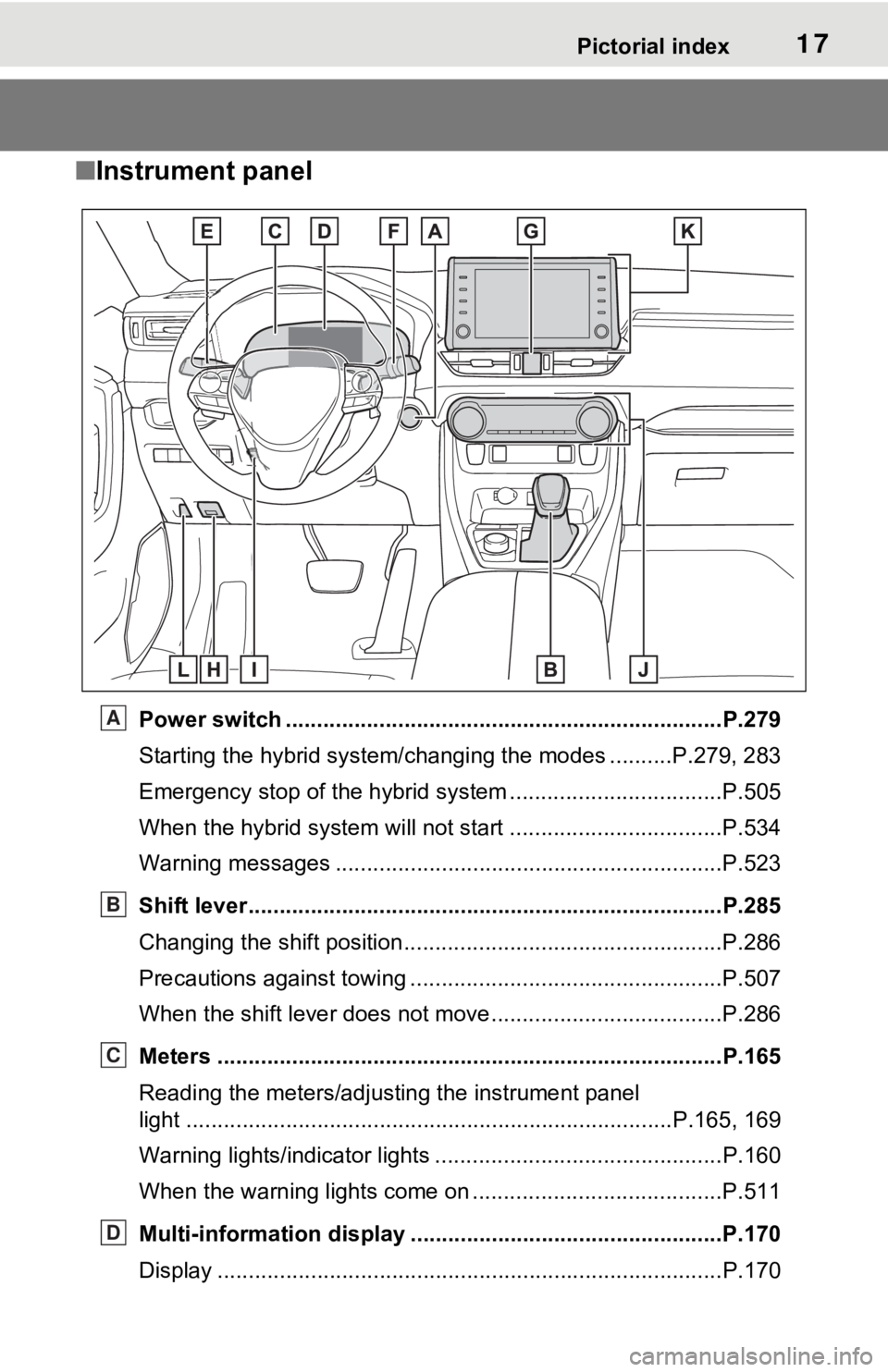
17Pictorial index
■Instrument panel
Power switch ................................................... ...................P.279
Starting the hybrid system/chan ging the modes ..........P.279, 283
Emergency stop of the hybrid system ............................ ......P.505
When the hybrid system will not start .......................... ........P.534
Warning messages ..............................................................P.523
Shift lever.................................................... ........................P.285
Changing the shift position.................................... ...............P.286
Precautions against towing ..................................................P.507
When the shift lever does not move............................. ........P.286
Meters ......................................................... ........................P.165
Reading the meters/adjusting the instrument panel
light .......................................................... ....................P.165, 169
Warning lights/indicator lights ................................ ..............P.160
When the warning lights come on ................................ ........P.511
Multi-information display . .................................................P.170
Display .................................................................................P.170A
B
C
D
Page 26 of 616
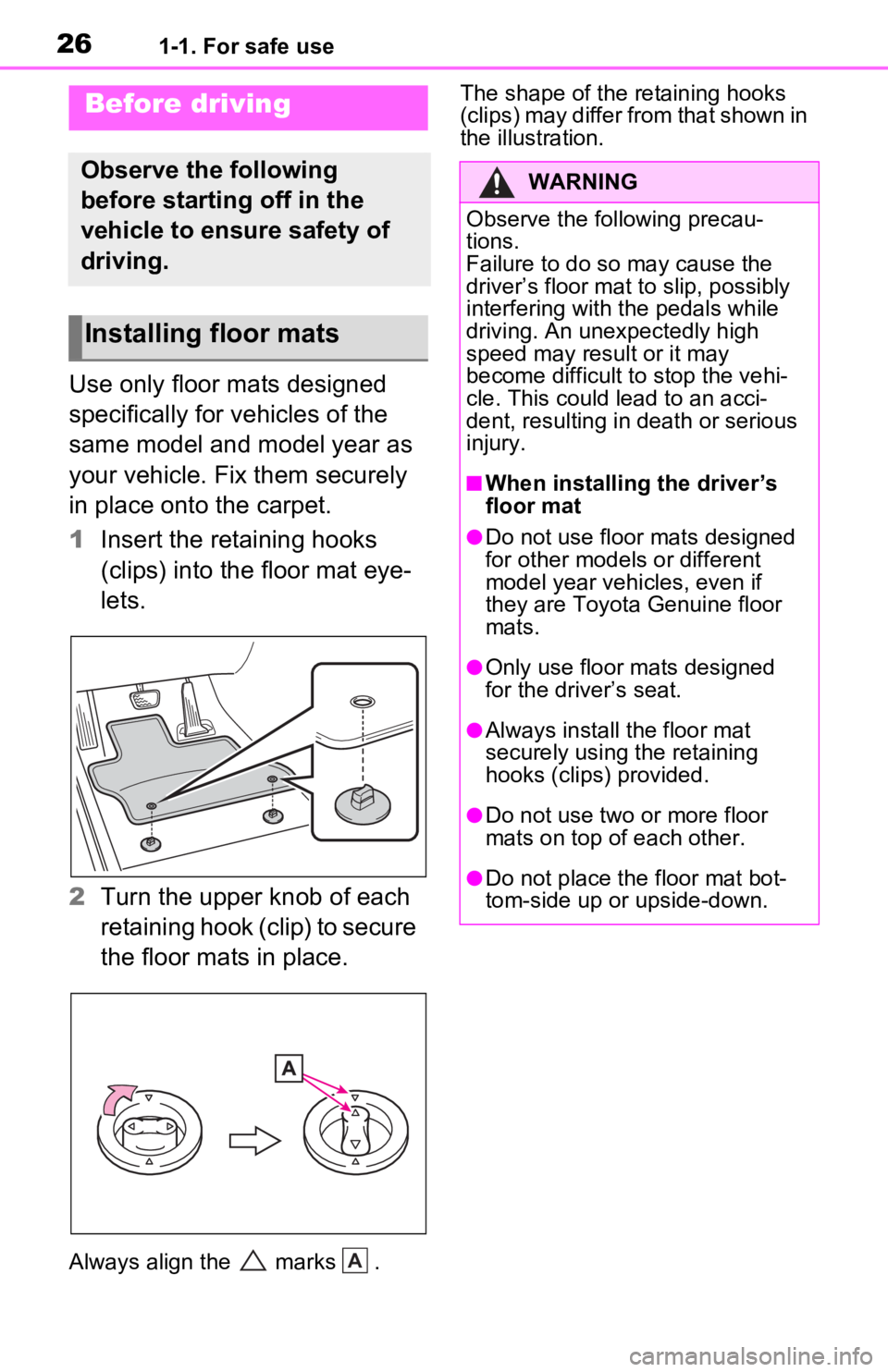
261-1. For safe use
1-1.For safe use
Use only floor mats designed
specifically for vehicles of the
same model and model year as
your vehicle. Fix them securely
in place onto the carpet.
1Insert the retaining hooks
(clips) into the floor mat eye-
lets.
2 Turn the upper knob of each
retaining hook (clip) to secure
the floor mats in place.
Always align the marks . The shape of the retaining hooks
(clips) may differ from that shown in
the illustration.
Before driving
Observe the following
before starting off in the
vehicle to ensure safety of
driving.
Installing floor mats
A
WARNING
Observe the following precau-
tions.
Failure to do so may cause the
driver’s floor mat to slip, possibly
interfering with t
he pedals while
driving. An unexpectedly high
speed may result or it may
become difficult to stop the vehi-
cle. This could lead to an acci-
dent, resulting in death or serious
injury.
■When installing the driver’s
floor mat
●Do not use floor mats designed
for other models or different
model year vehicles, even if
they are Toyota Genuine floor
mats.
●Only use floor mats designed
for the driver’s seat.
●Always install the floor mat
securely using the retaining
hooks (clips) provided.
●Do not use two or more floor
mats on top of each other.
●Do not place the floor mat bot-
tom-side up or upside-down.
Page 28 of 616
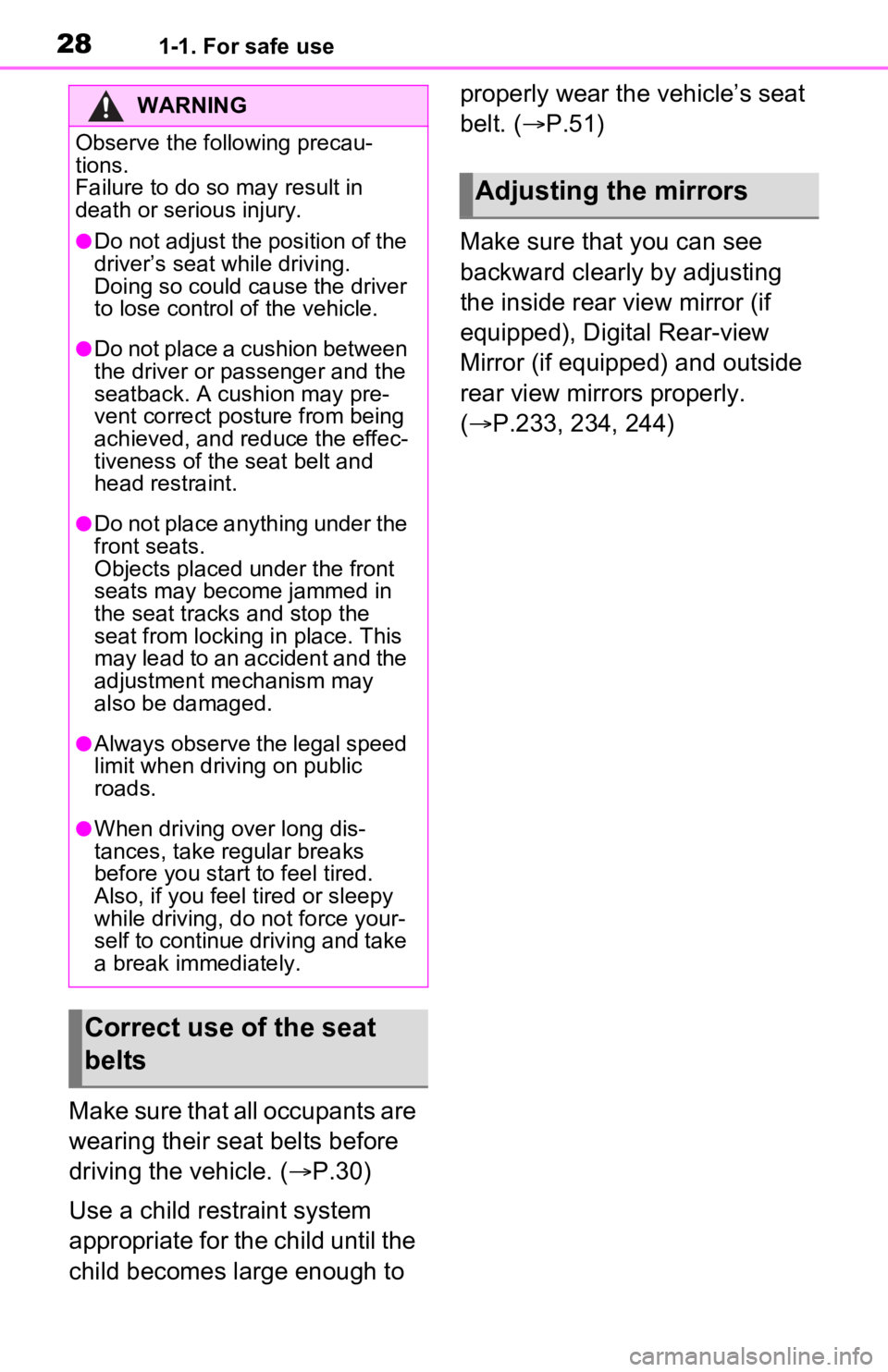
281-1. For safe use
Make sure that all occupants are
wearing their seat belts before
driving the vehicle. (P.30)
Use a child restraint system
appropriate for the child until the
child becomes large enough to properly wear the vehicle’s seat
belt. (
P.51)
Make sure that you can see
backward clearly by adjusting
the inside rear view mirror (if
equipped), Digital Rear-view
Mirror (if equipped) and outside
rear view mirrors properly.
( P.233, 234, 244)
WARNING
Observe the following precau-
tions.
Failure to do so m ay result in
death or serious injury.
●Do not adjust the position of the
driver’s seat while driving.
Doing so could cause the driver
to lose control of the vehicle.
●Do not place a cushion between
the driver or passenger and the
seatback. A cushion may pre-
vent correct pos ture from being
achieved, and reduce the effec-
tiveness of the seat belt and
head restraint.
●Do not place anything under the
front seats.
Objects placed under the front
seats may become jammed in
the seat tracks and stop the
seat from locking in place. This
may lead to an accident and the
adjustment mechanism may
also be damaged.
●Always observe the legal speed
limit when driving on public
roads.
●When driving over long dis-
tances, take regular breaks
before you start to feel tired.
Also, if you feel tired or sleepy
while driving, do not force your-
self to continue driving and take
a break immediately.
Correct use of the seat
belts
Adjusting the mirrors
Page 73 of 616

731-4. Theft deterrent system
1
For safety and security
*: If equipped
■Items to check before lock-
ing the vehicle
To prevent unexpected trigger-
ing of the alarm and vehicle
theft, make sure of the following:
Nobody is in the vehicle.
The side windows and moon
roof (if equipped) or pan-
oramic moon roof (if
equipped) are closed before
the alarm is set.
No valuables or other per-
sonal items are left in the
vehicle.
■Setting
Close the doors and hood, and lock all the doors. The system
will be set automatically after 30
seconds.
The security indicator changes from
being on to flashing when the sys-
tem is set.
If all doors are closed with hood
open, alarm system can be set.
(
P.73)
■Canceling or stopping
Do one of the following to deac-
tivate or stop the alarm:
Unlock the doors.
Turn the power switch to ACC
or ON, or start the hybrid sys-
tem. (The alarm will be deacti-
vated or stopped after a few
seconds.)
■System maintenance
The vehicle has a maintenance-free
type alarm system.
■Triggering of the alarm
The alarm may be triggered in the
following situations:
(Stopping the alarm deactivates the
alarm system.)
●The doors are unlocked using the
mechanical key.
Alarm*
The alarm uses light and
sound to give an alert when
an intrusion is detected.
The alarm is triggered in the
following situations when
the alarm is set:
A locked door is unlocked or
opened in any way other
than using the entry func-
tion, wireless remote control
or mechanical key. (The
doors will lock again auto-
matically.)
The hood is opened.
Setting/canceling/stop-
ping the alarm system
Page 80 of 616
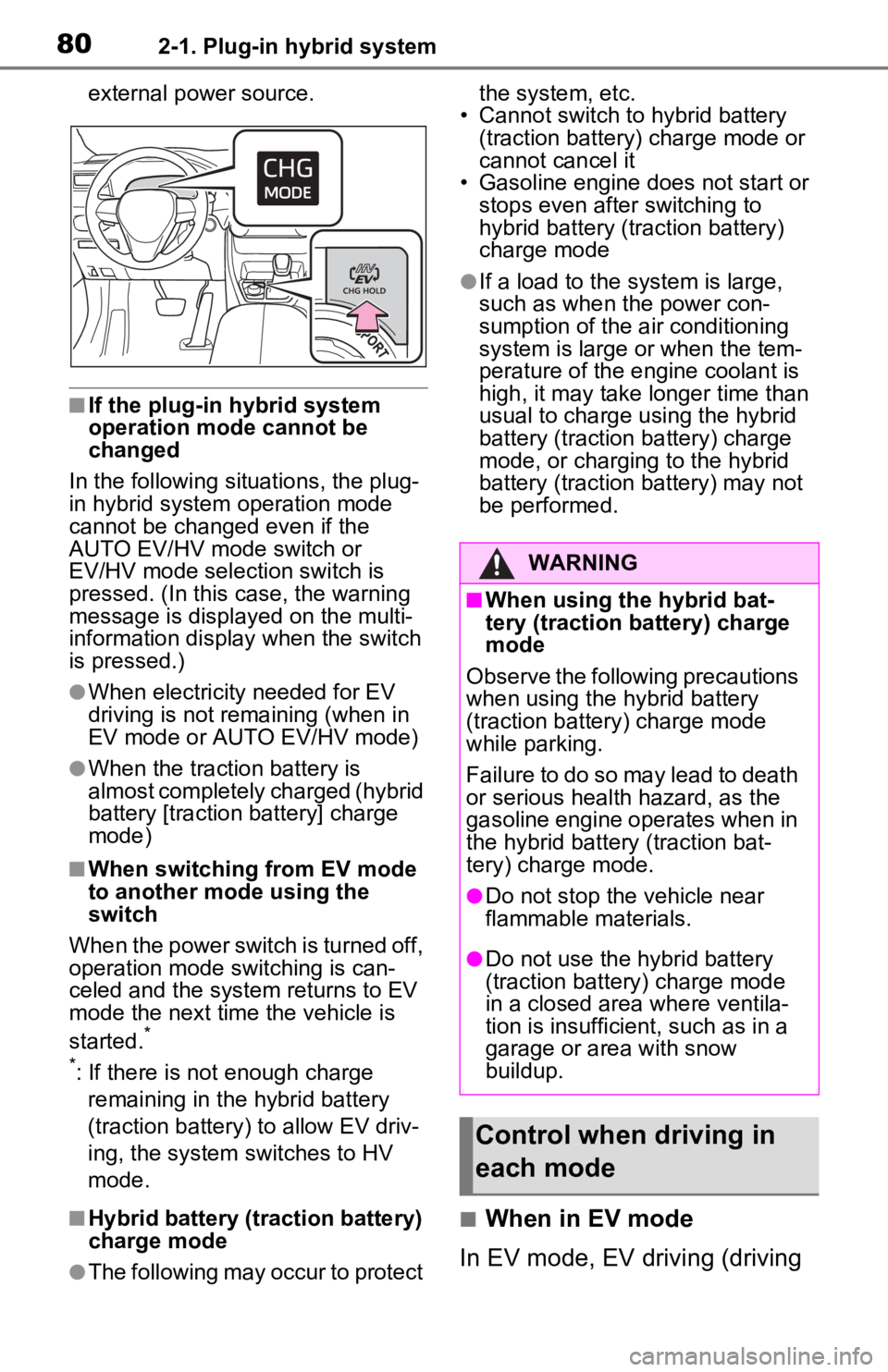
802-1. Plug-in hybrid system
external power source.
■If the plug-in hybrid system
operation mode cannot be
changed
In the following si tuations, the plug-
in hybrid system operation mode
cannot be changed even if the
AUTO EV/HV mode switch or
EV/HV mode selection switch is
pressed. (In this case, the warning
message is displaye d on the multi-
information displa y when the switch
is pressed.)
●When electricity needed for EV
driving is not remaining (when in
EV mode or AUTO EV/HV mode)
●When the traction battery is
almost completely charged (hybrid
battery [traction battery] charge
mode)
■When switching from EV mode
to another mode using the
switch
When the power switch is turned off,
operation mode switching is can-
celed and the system returns to EV
mode the next time the vehicle is
started.
*
*
: If there is not enough charge remaining in the hybrid battery
(traction battery) to allow EV driv-
ing, the system s witches to HV
mode.
■Hybrid battery (traction battery)
charge mode
●The following may occur to protect the system, etc.
• Cannot switch to hybrid battery (traction battery) charge mode or
cannot cancel it
• Gasoline engine does not start or stops even after switching to
hybrid battery (traction battery)
charge mode
●If a load to the system is large,
such as when the power con-
sumption of the air conditioning
system is large or when the tem-
perature of the engine coolant is
high, it may take longer time than
usual to charge using the hybrid
battery (traction battery) charge
mode, or charging to the hybrid
battery (traction battery) may not
be performed.
■When in EV mode
In EV mode, EV driving (driving
WARNING
■When using the hybrid bat-
tery (traction battery) charge
mode
Observe the following precautions
when using the hybrid battery
(traction battery) charge mode
while parking.
Failure to do so may lead to death
or serious health hazard, as the
gasoline engine operates when in
the hybrid battery (traction bat-
tery) charge mode.
●Do not stop the vehicle near
flammable materials.
●Do not use the hybrid battery
(traction battery) charge mode
in a closed area where ventila-
tion is insufficien t, such as in a
garage or area with snow
buildup.
Control when driving in
each mode
Page 81 of 616

812-1. Plug-in hybrid system
2
Plug-in hybrid system
using only the electric motor)* is
possible. However, depending
on the situation, EV driving may
be canceled and both gasoline
engine and electric motor are
used ( P.82). Also, if a little
electricity is remaining in the
hybrid battery (traction battery),
HV mode is automatically
selected. To drive in EV mode
long, observe the followings.
Avoid sudden acceleration
and sudden deceleration, and
be sure to drive smoothly. If
you repeatedly accelerate,
the hybrid battery (traction
battery) charge will deplete
quickly. Also, EV driving may
be canceled by rapid acceler-
ation or vehicle speed.
Restrain your speed as much
as possible. The distance that
can be driven in EV mode will
reduce considerably at high
speeds.
*: The EV driving range can be
checked using the multi-informa-
tion display. ( P.172)
■When in AUTO EV/HV mode
Only the electric motor is used
for EV driving
* during normal
driving, but when the accelera-
tor pedal is strongly depressed,
the gasoline engine starts.
( P.82)
Also, when the hybrid battery
(traction battery) level is low, the
mode switches to HV mode automatically the same as in EV
mode.
AUTO EV/HV mode is suitable
for driving conditions when more
power is required, such as for
driving uphill or accelerating
suddenly. However, because
the gasoline engine will start
more easily, it is recommended
to drive in EV mode usually.
*: The EV driving range can be
checked using th e multi-informa-
tion display. ( P.172)
■When in HV mode
The vehicle can be used in the
same way as a standard hybrid
vehicle.
In HV mode, controls are pri-
marily carried out as follows in
accordance with the driving con-
ditions.
The gasoline engine stops
*
when the vehicle is stopped.
During start off, the electric
motor (traction motor) drives
the vehicle.
During normal driving, the
gasoline engine and electric
motor (traction motor) are
controlled effectively, and the
vehicle is driven with optimum
fuel efficiency. Also, when
necessary, the electric motor
(traction motor) operates as
an electrical generator to
charge the hybrid battery
(traction battery).
Page 83 of 616

832-1. Plug-in hybrid system
2
Plug-in hybrid system
driving range (P.172) is being dis-
played on the multi-information dis-
play, EV driving (driving using only
the electric motor) may be canceled
and both gasoline engine and elec-
tric motor are used depending on
the situation (EV driving will be
returned to automatically after EV
driving becomes possible again).
EV driving may be canceled auto-
matically in the following circum-
stances
*1:
●When vehicle speed is more than
approximately 84 mph (135 km/h).
●When power is needed temporar-
ily, for example when the acceler-
ator pedal is depressed firmly or
when accelerating suddenly.
*2
●When the temperature of the
hybrid system is high.
The vehicle has been left in the
sun, driven on a hill, driven at high
speeds, etc.
●When the temperature of the
hybrid system is low.
●When the heater is switched on
when the outside temperature is
below about 14°F (-10°C).
●When the windshield defogger
switch is pressed. ( P.398)
●When the system determines that
the gasoline engine needs to be
started.
*1: The gasoline engine may also
operate in circumstances other
than those listed above, depend-
ing on conditions.
*2: When driving in AUTO EV/HV mode. Even in EV mode, the gas-
oline engine may start, depend-
ing on the condition of the hybrid
battery (traction battery).
■If “Engine Started to Protect
System EV driving unavailable”
is displayed on the multi-infor-
mation display
EV driving may be canceled in order to protect the hybrid system, etc.
In this case, perform driving with the
gasoline engine until EV driving will
be returned to automatically.
■Conditions in which the gaso-
line engine may not stop
The gasoline engine starts and
stops automatically. However, it
may not stop automatically in the
following conditions
*:
●During gasoline engine warm-up
●During hybrid battery (traction bat-
tery) charging
●When the temperature of the
hybrid battery (traction battery) is
high or low
●When the windshield defogger
switch is pressed. ( P.398)
*: Depending on the circumstances,
the gasoline engine may also not
stop automatically in situations
other than those above.
■Sounds and vibrations specific
to a hybrid vehicle
There may be no e ngine sound or
vibration even thoug h the vehicle is
able to move with the “READY” indi-
cator is illuminated. For safety,
apply the parking brake and make
sure to shift the shift lever to P when
parked.
The following sounds or vibrations
may occur when the hybrid system
is operating and are not a malfunc-
tion.
●Motor sounds may be heard from
the engine compartment.
●Sounds may be heard from the
hybrid battery (traction battery)
when the hybrid sy stem starts or
stops.
●Relay operating sounds such as a
snap or soft clank will be emitted
from the hybrid ba ttery (traction
battery), behind the rear seats,
when the hybrid system is started
or stopped.
Page 84 of 616
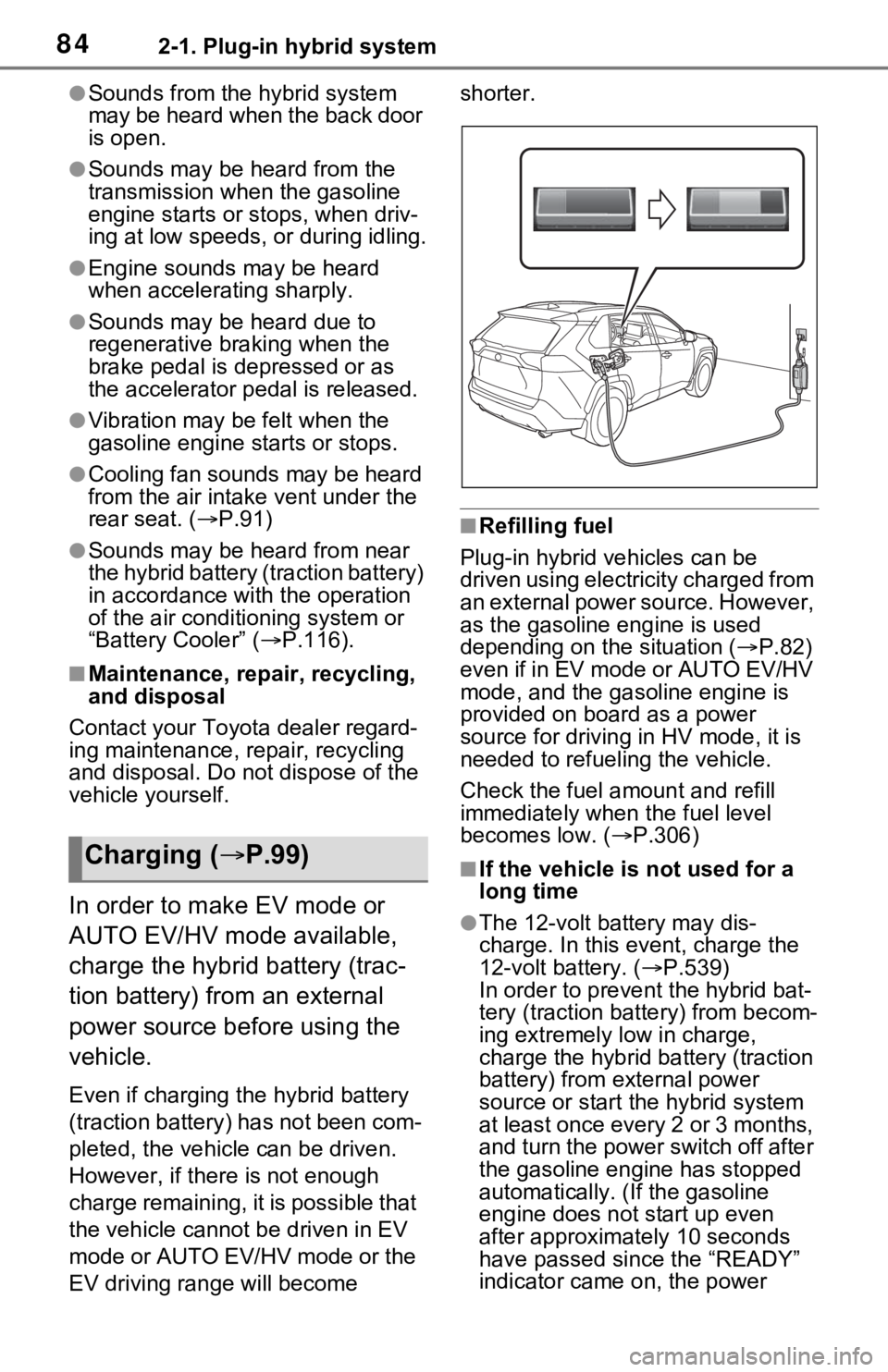
842-1. Plug-in hybrid system
●Sounds from the hybrid system
may be heard when the back door
is open.
●Sounds may be heard from the
transmission when the gasoline
engine starts or stops, when driv-
ing at low speeds, or during idling.
●Engine sounds may be heard
when accelerating sharply.
●Sounds may be heard due to
regenerative braking when the
brake pedal is dep ressed or as
the accelerator pedal is released.
●Vibration may be felt when the
gasoline engine starts or stops.
●Cooling fan sounds may be heard
from the air intake vent under the
rear seat. ( P.91)
●Sounds may be heard from near
the hybrid battery (traction battery)
in accordance with the operation
of the air conditioning system or
“Battery Cooler” ( P.116).
■Maintenance, repair, recycling,
and disposal
Contact your Toyota dealer regard-
ing maintenance, repair, recycling
and disposal. Do not dispose of the
vehicle yourself.
In order to make EV mode or
AUTO EV/HV mode available,
charge the hybrid battery (trac-
tion battery) from an external
power source before using the
vehicle.
Even if charging t he hybrid battery
(traction battery) has not been com-
pleted, the vehicle can be driven.
However, if there is not enough
charge remaining, it is possible that
the vehicle canno t be driven in EV
mode or AUTO EV/HV mode or the
EV driving range will become shorter.
■Refilling fuel
Plug-in hybrid vehicles can be
driven using electricity charged from
an external power source. However,
as the gasoline engine is used
depending on the situation ( P.82)
even if in EV mode or AUTO EV/HV
mode, and the gasoline engine is
provided on board as a power
source for driving in HV mode, it is
needed to refueling the vehicle.
Check the fuel a mount and refill
immediately when the fuel level
becomes low. ( P.306)
■If the vehicle is not used for a
long time
●The 12-volt battery may dis-
charge. In this e vent, charge the
12-volt battery. ( P.539)
In order to prevent the hybrid bat-
tery (traction batt ery) from becom-
ing extremely low in charge,
charge the hybrid battery (traction
battery) from external power
source or start th e hybrid system
at least once every 2 or 3 months,
and turn the power switch off after
the gasoline engine has stopped
automatically. ( If the gasoline
engine does not start up even
after approximately 10 seconds
have passed since the “READY”
indicator came on, the power
Charging ( P.99)
Page 92 of 616
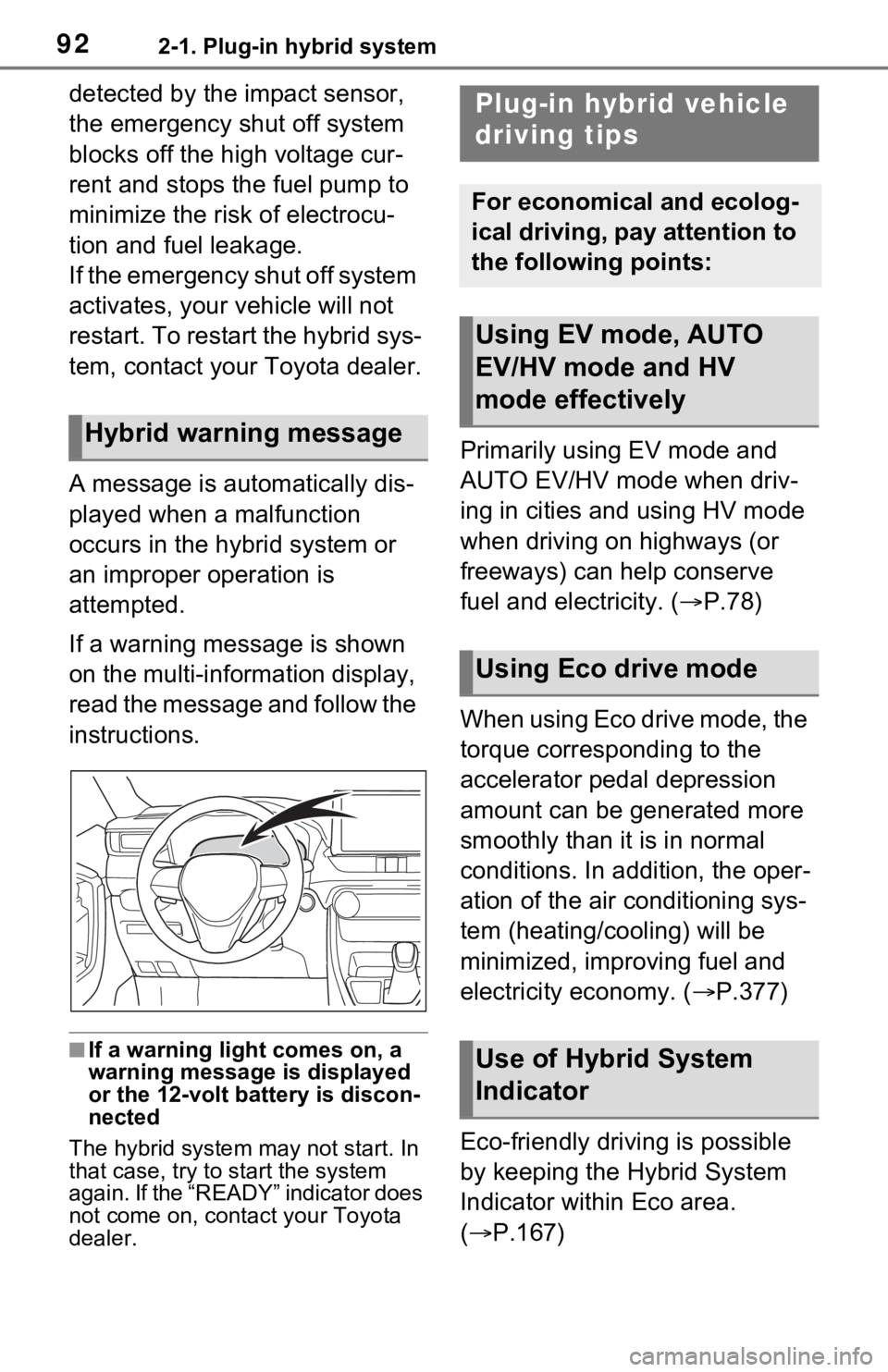
922-1. Plug-in hybrid system
detected by the impact sensor,
the emergency shut off system
blocks off the high voltage cur-
rent and stops the fuel pump to
minimize the risk of electrocu-
tion and fuel leakage.
If the emergency shut off system
activates, your vehicle will not
restart. To restart the hybrid sys-
tem, contact your Toyota dealer.
A message is automatically dis-
played when a malfunction
occurs in the hybrid system or
an improper operation is
attempted.
If a warning message is shown
on the multi-information display,
read the message and follow the
instructions.
■If a warning light comes on, a
warning message is displayed
or the 12-volt battery is discon-
nected
The hybrid system may not start. In
that case, try to start the system
again. If the “READY” indicator does
not come on, contact your Toyota
dealer.
Primarily using EV mode and
AUTO EV/HV mode when driv-
ing in cities and using HV mode
when driving on highways (or
freeways) can help conserve
fuel and electricity. ( P.78)
When using Eco drive mode, the
torque corresponding to the
accelerator pedal depression
amount can be generated more
smoothly than it is in normal
conditions. In addition, the oper-
ation of the air conditioning sys-
tem (heating/cooling) will be
minimized, improving fuel and
electricity economy. ( P.377)
Eco-friendly driving is possible
by keeping the Hybrid System
Indicator within Eco area.
( P.167)Hybrid warning message
Plug-in hybrid vehicle
driving tips
For economical and ecolog-
ical driving, pay attention to
the following points:
Using EV mode, AUTO
EV/HV mode and HV
mode effectively
Using Eco drive mode
Use of Hybrid System
Indicator
Page 96 of 616

962-1. Plug-in hybrid system
of occupants.
The distance that EV driving is
possible can be extended if the
following is performed:
■When starting off, depress
the accelerator pedal
smoothly to accelerate
As a guide, accelerate up to
approximately 12mph (20 km/h)
in the first 5 seconds.
Electrical and fuel efficiency can
be improved just by using the
ECO Accelerator Guidance dis-
played on the multi-information
display and taking care to start
off gently. ( P.173)
When the driving mode is set to
Eco drive mode, depressing the
accelerator pedal generates
smooth torque that makes it easier
to operate the accelerator gently.
At the same time, the air condition-
ing control is switched to eco air
conditioning mode ( P.397) to
reduce the strength of the air condi-
tioning operation.
■Maintain sufficient vehicle-
to-vehicle distance and do
not accelerate or decelerate
unnecessarily
Try to maintain a fixed speed
while driving. Driving at a short
vehicle-to-vehicle distance will
result in repeating wasteful
acceleration and deceleration,
which will worsen the electrical
and fuel efficiency.
■Release the accelerator
pedal early before stopping
the vehicle, such as at a
traffic light
The regenerative brake will
operate to convert the kinetic
energy of the vehicle into electri-
cal energy, which will charge the
hybrid battery (traction battery).
The regeneration status can be
checked from the Hybrid Sys-
tem Indicator. ( P.167)
When the brake pedal is
depressed lightly during decel-
eration, the regeneration
amount increases, enabling
more electrical energy to be
recovered.
If the brake pedal is depressed too
strongly, the recovered amount
indicator will reac h the maximum
level and the upper limit of the
recoverable energy will be
exceeded. Theref ore, be sure to
operate the brak e pedal early.
■Use the air conditioning
system appropriately, and
also utilize the heated steer-
ing wheel (if equipped) and
seat heaters
In EV mode, the vehicle is
cooled and heated by electrical
energy. (Except in extremely
cold temperatures of approxi-
mately 14°F (-10°C) or less.)
Preventing excessive cooling or
heating of the vehicle will reduce
power consumption and
improve electrical efficiency.